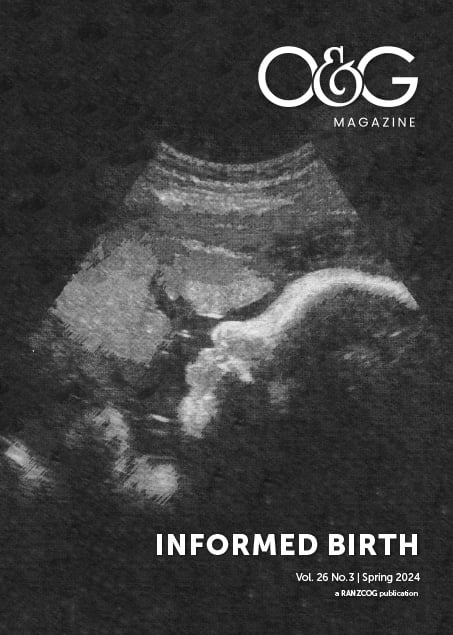There has been discussion recently about informed consent in obstetrics in light of the parliamentary inquiry into birth trauma in New South Wales and associated national media coverage. The outcome and impact of this is still developing; however, the core legal principles remain settled and should continue to guide how you communicate with and obtain consent from patients.
Consent essentials
Obtaining patient consent through a shared decision-making process is an essential part of clinical practice. This requires clear and effective communication between doctor and patient, including discussion about the risks and benefits of proposed treatment and interventions.1
This is a well-established legal principle and reflected in professional standards such as the Medical Board of Australia’s Good medical practice: a code of conduct for doctors in Australia2.
The legal duty is to provide information that any patient would reasonably need to know, and information that the individual patient would consider is material to their decision. This is a patient-centred test, and the discussion should be tailored to the patient’s specific needs and concerns.
An adult with decision-making capacity has the right to refuse examinations, treatments or procedures. This applies when seeking consent from pregnant patients about treatment for her or the unborn fetus.
Avant’s experience and data analysis indicate that the most common consent concerns are patients reporting that they had been given insufficient information or did not feel fully informed after the consent process.
Obtaining consent
For many aspects of antenatal care, verbal consent is appropriate. That includes for routine physical examinations, ultrasounds, and taking samples for pathology testing. However, it is important to never assume consent, particularly for intimate examinations.
Doctors have found themselves the subject of complaints where they have assumed a patient was consenting when they did not actively object to an examination. As well as discussing the need for any test or examination, make sure the patient understands what is involved and give them an opportunity to ask questions or express any concerns.
Except in a life-threatening emergency, patients need to give consent to an intervention or procedure. This applies to caesarean section or use of instruments during delivery, and other interventions such as an episiotomy.
It does not mean that specific consent is required for vaginal delivery, since vaginal delivery is not an intervention. However, there should be discussion with patients about what to expect during the delivery, the issues or complications that may arise, and what other options for delivery may be needed.
The antenatal period provides a good opportunity for multiple discussions about these issues. As a doctor, your level of individual involvement in this process will vary across private practice and public hospital settings.
Ideally pregnant patients who are developing birth plans will be able to discuss their preferences with their healthcare team well in advance of their delivery. This can provide a good framework for discussing the material risks with the patient and reaching a shared decision about how to proceed if those risks eventuate.
Such discussions may bring to light cultural factors that may influence a patient’s engagement with healthcare. It will also highlight the patient’s expectations and provide time for any unrealistic expectations to be addressed.
Ultimately, the doctor who performs a procedure is responsible for satisfying themselves that the patient has provided informed consent. They do not need to personally provide all the information or have every discussion themselves. This highlights that consent is a process – the consent form is the final step in the process and evidence that the patient has agreed to proceed with the proposed treatment. This can also be documented by the treating team in the patient’s records.
Many health departments and public hospitals have developed policies on antenatal and birth consent and when written consent will be required. These sometimes require written consent for certain procedures and that consent be confirmed at the time of the procedure.3
Communication between carers
In the case of a shared-care arrangement, it is important that all members of the patient’s care team are providing consistent information to the patient and have a shared understanding of what has been agreed.
Under Australian Privacy Law4, healthcare providers are permitted to share a patient’s health information between members of a patient’s treating team. However, do discuss this with the patient and check they understand what information will be shared and with whom, so that they have an opportunity to raise any concerns.
Challenging decisions
Sometimes, even after thorough communication, a patient wishes to deliver their baby in a certain way or in a particular setting that goes against your clinical advice. Or they may indicate they do not want certain interventions, such as forceps during delivery. A pregnant patient is entitled to refuse treatment, even if that refusal has the potential to harm the unborn child.
This can be particularly challenging for doctors. If you believe that a birth or shared-care plan poses unacceptable risks to parent or baby, you do not have to support it.
In such cases, practitioners should explain the risks to mother and baby clearly and in a way the patient can understand. We recommend that you confirm this information in writing to the patient and the rest of treating team. You can continue to raise your concerns throughout the pregnancy, particularly as new information comes to light. Never assume that the pregnant patient has made up their mind and discussing the risks would serve no purpose.
This can be a difficult balancing act where patients have strongly held views and there is a risk they will disengage with healthcare altogether. By continuing to provide care and trying to accommodate patients’ needs you will not be seen as endorsing an unsafe course. However, you must ensure that the risks are made clear to the patient and that they are accepting of those risks.
Ensure you document all your discussions, particularly where patients indicate they may proceed against your clinical advice. Document the specific risks discussed along with the possible adverse outcomes for the child and mother. This includes using the terms ‘death’ and ‘disability’ if these are reasonably foreseeable clinical risks.
If you do have grave concerns for the baby’s welfare, some jurisdictions have provisions for making pre-natal child safety reports under state child protection legislation.
Consent in urgent and unplanned situations
Ideally, the period of antenatal care will have provided an opportunity to discuss various options and interventions if things do not go to plan and decisions need to be made urgently.
If such a situation arises, shared decision-making means explaining the risks and options to the patient, give them the benefit of your expertise, and helping them reach a decision.
Doctors are permitted to act without consent where a patient is unable to consent in the case of a life-threatening emergency. However, the fact that a pregnant patient is making decisions you consider irrational does not necessarily mean they have lost capacity.
A UK court was prepared to find that a pregnant patient’s needle phobia meant she had temporarily lost capacity when she withdrew consent to a planned caesarean which would have involved anaesthesia by injection. However, the court was also clear that panic, indecisiveness or irrationality do not themselves amount to lack of capacity. These cases are rarely clear cut so always seek advice in such a situation.
Look after yourself
We know difficult cases are deeply distressing for all healthcare staff involved. Seek advice and support from your college, or one of the support services available to healthcare professionals such as the Doctors’ Health Advisory Service in your state or territory5.
Avant members can contact us for medico-legal assistance and support, including after-hours support in emergencies.
Further reading
NSW Health. Consent requirements for pregnancy and birth, August 2020.
SA Health. South Australian perinatal practice guideline. Labour and birth care, March 2022
Safer Care Victoria, Care during labour and birth, November 2019
RANZCOG, Clinical governance advice, Shared Maternity Care in Australia, March 2021
References
- Avant, Consent: Consent: the essentials Avant, Member eLearning, Consent: Informed consent and more. Avant, Claims and complaints insights: Obstetrics and gynaecology, March 2023.
- Good medical practice: a code of conduct for doctors in Australia, Medical Board of Australia
- NSW Health Connecting, listening and responding: A Blueprint for Action – Maternity Care in NSW – Health professionals, August 2023
- Office of the Australian Information Commissioner – Privacy Guidance for Health Service Providers
- RANZCOG wellbeing resources






Leave a Reply